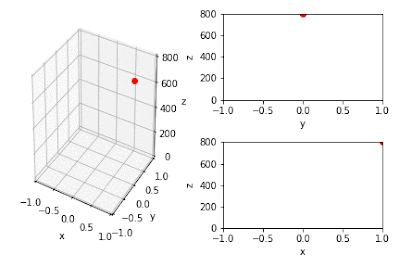The result is:
This page shows how to combine 3D and 2D animations in one figure using python, matplotlib.pyplot, and animation.timedanimation function.
This code is based on the following websites:
- animation example code: subplots.py - matplotlib -
- animation example code: simple_3danim.py - matplotlib -
- 3D animation using matplotlib - stackoverflow -
See also:
Combine two 2D animations in one figure using python, matplotlib.pyplot and animation.timedanimation
Example code for python animation: combine 3D and 2D animations in one figure using python, matplotlib.pyplot, and matplotlib.animation.artistanimation
This page shows how to generate 3D animation of scatter plot using animation.FuncAnimation, python, and matplotlib.pyplot. By updating the data to plot and using set_3d_properties, you can animate the 3D scatter plot.
In [1]:
import numpy as np
import matplotlib.pyplot as plt
import matplotlib.animation as animation
import mpl_toolkits.mplot3d.axes3d as p3
from IPython.display import HTML
from matplotlib.lines import Line2D
from mpl_toolkits.mplot3d.art3d import Line3D
Define the animation function used in FuncAnimation function.
In [2]:
class SubplotAnimation(animation.TimedAnimation):
def __init__(self):
fig = plt.figure()
ax1 = fig.add_subplot(1, 2, 1,projection="3d")
ax2 = fig.add_subplot(2, 2, 2)
ax3 = fig.add_subplot(2, 2, 4)
self.t = np.linspace(0, 80, 300)
self.x = np.cos(2 * np.pi * self.t / 10.)
self.y = np.sin(2 * np.pi * self.t / 10.)
self.z = 10 * self.t
ax1.set_xlabel('x')
ax1.set_ylabel('y')
ax1.set_zlabel('z')
self.line1 = Line3D([], [], [], color='black')
self.line1a = Line3D([], [], [], color='red', linewidth=2)
self.line1e = Line3D(
[], [],[], color='red', marker='o', markeredgecolor='r')
ax1.add_line(self.line1)
ax1.add_line(self.line1a)
ax1.add_line(self.line1e)
ax1.set_xlim(-1, 1)
ax1.set_ylim(-1, 1)
ax1.set_zlim(0, 800)
#ax1.set_aspect('equal', 'datalim')
ax2.set_xlabel('y')
ax2.set_ylabel('z')
self.line2 = Line2D([], [], color='black')
self.line2a = Line2D([], [], color='red', linewidth=2)
self.line2e = Line2D(
[], [], color='red', marker='o', markeredgecolor='r')
ax2.add_line(self.line2)
ax2.add_line(self.line2a)
ax2.add_line(self.line2e)
ax2.set_xlim(-1, 1)
ax2.set_ylim(0, 800)
ax3.set_xlabel('x')
ax3.set_ylabel('z')
self.line3 = Line2D([], [], color='black')
self.line3a = Line2D([], [], color='red', linewidth=2)
self.line3e = Line2D(
[], [], color='red', marker='o', markeredgecolor='r')
ax3.add_line(self.line3)
ax3.add_line(self.line3a)
ax3.add_line(self.line3e)
ax3.set_xlim(-1, 1)
ax3.set_ylim(0, 800)
plt.tight_layout()
animation.TimedAnimation.__init__(self, fig, interval=50, blit=True)
def _draw_frame(self, framedata):
i = framedata
head = i - 1
head_slice = (self.t > self.t[i] - 1.0) & (self.t < self.t[i])
self.line1.set_data(self.x[:i], self.y[:i])
self.line1.set_3d_properties(self.z[:i])
self.line1a.set_data(self.x[head_slice], self.y[head_slice])
self.line1a.set_3d_properties(self.z[head_slice])
self.line1e.set_data(self.x[head], self.y[head])
self.line1e.set_3d_properties(self.z[head])
self.line2.set_data(self.y[:i], self.z[:i])
self.line2a.set_data(self.y[head_slice], self.z[head_slice])
self.line2e.set_data(self.y[head], self.z[head])
self.line3.set_data(self.x[:i], self.z[:i])
self.line3a.set_data(self.x[head_slice], self.z[head_slice])
self.line3e.set_data(self.x[head], self.z[head])
self._drawn_artists = [self.line1, self.line1a, self.line1e,
self.line2, self.line2a, self.line2e,
self.line3, self.line3a, self.line3e]
def new_frame_seq(self):
return iter(range(self.t.size))
def _init_draw(self):
lines = [self.line1, self.line1a, self.line1e,
self.line2, self.line2a, self.line2e,
self.line3, self.line3a, self.line3e]
for l in lines:
l.set_data([], [])
ani = SubplotAnimation()
Save the animation in the mp4 and gif format using ffmpeg and imagemagick, respectively.
In [3]:
fn = 'line_animation_3d_with_two_2d_timedanimation'
ani.save('%s.mp4'%(fn), writer='ffmpeg',fps=1000/50)
ani.save('%s.gif'%(fn), writer='imagemagick',fps=1000/50)
Reduce the size of the GIF file using imagemagick
In [4]:
import subprocess
cmd = 'magick convert %s.gif -fuzz 10%% -layers Optimize %s_r.gif'%(fn,fn)
subprocess.check_output(cmd)
Out[4]:
Finaly, show the animation in the jupyter notebook.
In [5]:
plt.rcParams['animation.html'] = 'html5'
ani
Out[5]:



